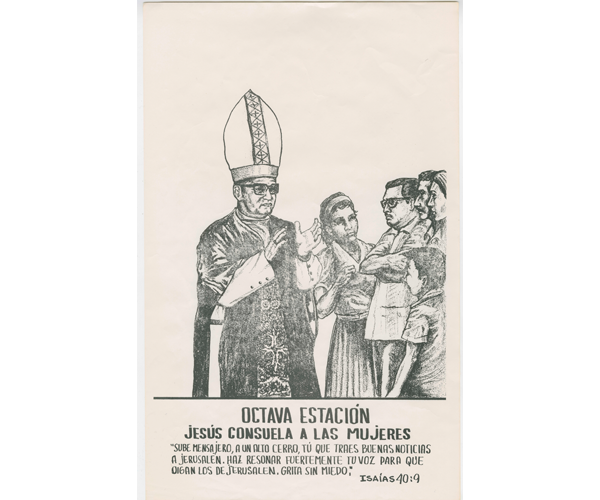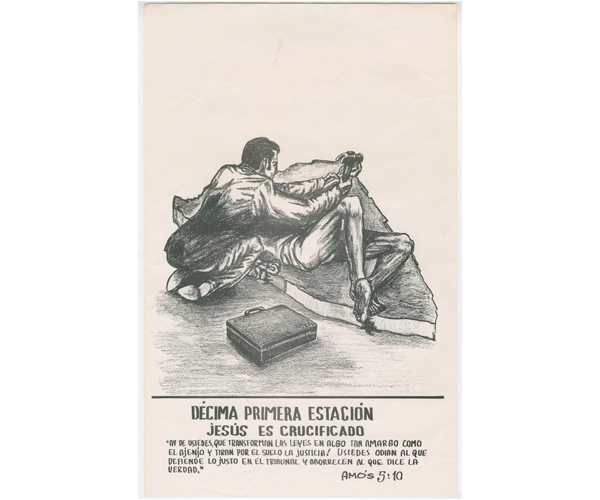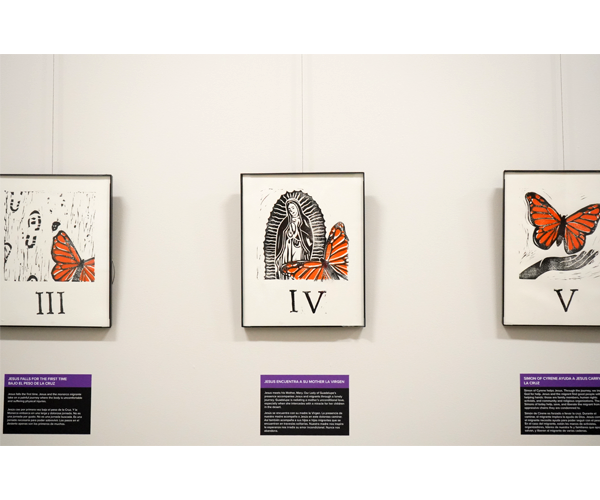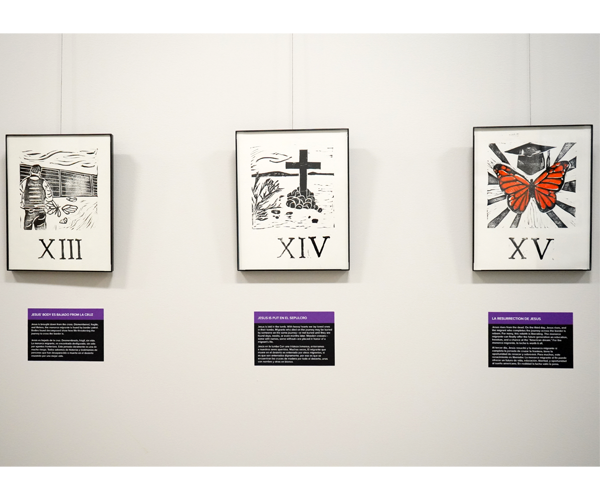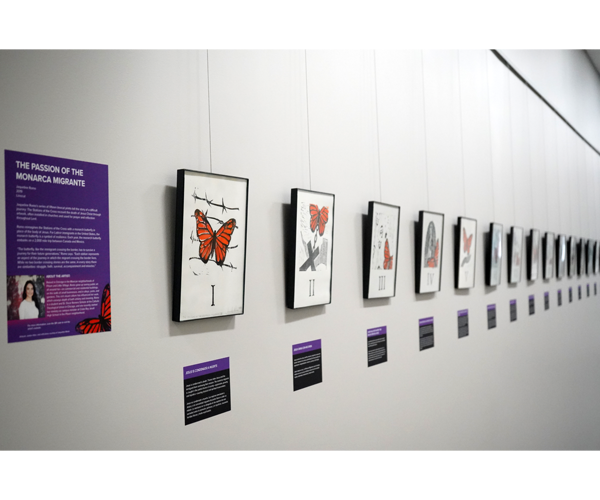Blogs
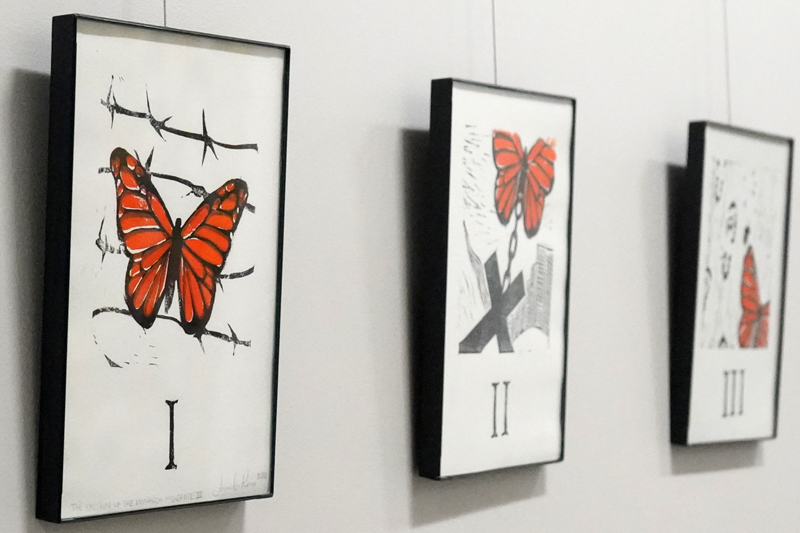
Many Ways of the Cross, One Resurrection
By Bridget Retzloff
The Stations of the Cross, also called the Way of the Cross, is a contemporary devotional practice based on historic pilgrimages to the Holy Land. While the devotion may be practiced without accompanying artwork, artistic representations of the places and events can help participants center their thoughts and imagine each station. Often Stations of the Cross are composed of 14 pieces of artwork depicting Jesus Christ’s suffering and death. Sometimes a 15th station is included, featuring the Resurrection. They are often on display year-round in or near Catholic churches but may be used in guided reflections for groups during the Lenten season that leads to Easter.
Artists have created versions of the Stations of the Cross in a wide variety of media. Authors have written reflections on the Way of the Cross that make connections with identity, time periods, specific figures in Christianity, nature, social issues and more. The Marian Library’s collections include artwork and books that may be used in this devotional practice, featuring connections with Mary, nature and social justice issues. A series currently on loan to Campus Ministry and on display in Roesch Library features these connections.
Mary
Traditionally, the fourth station is the one in which Jesus encounters his mother. Mary is also thought to have been present at the foot of the cross and/or the tomb and is sometimes depicted in later stations as Jesus is crucified, dies, and is buried. Participants may find that reflecting on Mary’s role and her anguish can be a powerful way to encounter the Stations of the Cross. Some authors have reimagined the Way of the Cross from Mary’s perspective, prompting reflection on her point of view at each stage (Furey, 1984/1999; Pfeifer, 1991/2007). “The Way of the Cross,” a pen and ink drawing by Sister Marian C. Honors, C.S.J., includes Mary in four stations (4. Jesus meets his afflicted mother; 12. Jesus dies on the Cross; 13. Jesus is taken down from the Cross; and 14. Jesus is laid in the tomb). Honors’ drawing has been adapted as coloring sheets that are available online to be printed and colored—perhaps a reflective Holy Week experience for all ages.
Nature
The natural world offers another perspective. Drawing from John Stokes and the Mary’s Gardens movement, artist Louise Tessier illustrates the writings of Father Thomas A. Stanley, S.M. Stanley’s 14 reflections reference flowers and plants with symbolism related to Mary or Jesus. For example, the eighth station, in which Jesus is condemned to death, asks the reader to consider the Lily of the Valley (Convallaria majalis), also known as Our Lady’s Tears. Stanley reflects, “This flower is said to have had its origin at the moment when Christ was condemned to death, for it was then that Mary wept; as her tears touched the earth, these flowers sprang up” (2013, p. 33). Tessier’s illustrations, created from the same linoleum printing blocks that were used to create a series of ceramic art tiles, feature the significant plants in each station within a border of thorns until the final station, in which Easter lilies herald the Resurrection. The plants intertwine with wooden crosses in some stations, but the stations depict no human figures. Stanley’s reflections and Tessier’s illustrations are paired in the book The Garden Way of the Cross, as well as a poster series of the same name.
Social Justice
In another series of prints in the Marian Library’s collection, the Stations of the Cross are reimagined as the death of Saint Óscar Romero. Romero was a Salvadoran archbishop whose opposition to violence in El Salvador and defense of the poor led to his assassination in 1980 while celebrating Mass at a hospital. As death threats toward Romero multiplied, he is said to have accepted death, just one similarity between his martyrdom and the Passion of Jesus Christ. The unknown artist of this series invites reflection on these similarities and honors the sacrifice of the saint who continues to be a symbol of hope for Salvadoran people.
The Passion of the Monarca Migrante
A series of 15 linocut prints by Romo invites reflection on Mary, nature and social justice. The Passion of the Monarca Migrante reimagines the Way of the Cross as the journey of a migrant, symbolized by the monarch butterfly. Romo’s reflections are written in both Spanish and English, and each has a title in Spanglish, a blend of the two languages. In the fourth station, “Jesus encuentra a su mother la Virgen,” the monarch butterfly meets Mary, depicted as Our Lady of Guadalupe. Romo writes,
Our Lady of Guadalupe’s presence accompanies Jesus and migrants through a lonely journey. Guadalupe is radiating a mother’s unconditional love especially when she intercedes with a miracle on her children in the desert.
By replacing the body of Jesus Christ with the butterfly, Romo reminds viewers to recognize the presence of Christ in each person. The monarch is a symbol of resilience found in nature, especially for Mexican immigrants to the United States, because of the multigenerational journey that the species takes each year from Mexico to the northern United States and Canada. Romo’s series also highlights the dangerous natural setting of the desert border crossing. By making connections between the Passion of Jesus Christ and the dangerous journey of migrants, Romo promotes hope in the Resurrection. The 15th station, “La Resurrection de Jesús,” features a resurrected monarch wearing a graduation cap. In the reflection for this station, Romo writes,
On the third day, Jesus rises and the migrant who completes the journey across the border rebirths. For many, this rebirth is liberating. The monarca migrante can finally offer the future generation an education, freedom, and a chance at the “American dream.” For the monarca migrante, la lucha is worth it all.
The Passion of the Monarca Migrante is on display on the second floor of Roesch Library until Monday, April 8. Romo spoke in early March as part of a Lenten program sponsored by Campus Ministry.
— Bridget Retzloff is an assistant professor and the Marian Library’s visual resources librarian. She manages the Marian Library's art collection, including over 13,000 artworks in many different media.
References
Furey, R.G. (1999). Mary’s Way of the Cross. Twenty-Third Publications. (Original work published 1984) https://flyers.udayton.edu/record=b2549306
Pfeifer, I. (2007). Mary’s Way of the Cross: Walking with the Mother of Jesus (M.J. Frisk, Trans.). Pauline Books & Media. (Original work published 1991) https://flyers.udayton.edu/record=b2058236
Stanley, T.A. (2013). The Garden Way of the Cross (L. Tessier, Illus.). Novalis. https://flyers.udayton.edu/record=b3217713
Stations of the Cross. (2003). In New Catholic Encyclopedia (2nd ed., Vol. 13, pp. 499-501). Gale. https://link.gale.com/apps/doc/CX3407710647/GVRL?u=dayt72472&sid=bookmark-GVRL&xid=5be83433

